SUMMARY
This is AI generated summarization, which may have errors. For context, always refer to the full article.
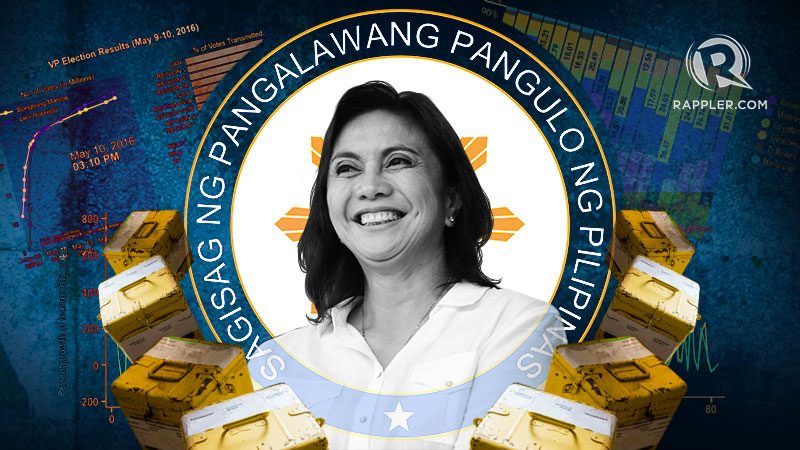


Vice President Leni Robredo’s shocking expulsion from the Duterte Cabinet this week has revived several issues from the hotly contested May elections.
Still at a loss over the unfortunate series of events, Leni speculated that her Cabinet ouster could be but one manifestation of a larger plot to “steal” the vice presidency, presumably to put into power her main election opponent, Bongbong Marcos.
No less than the President himself has repeatedly expressed support for Bongbong’s electoral protest before the Supreme Court. The President even boldly announced in Beijing that we could have a new vice president soon. Bongbong’s camp stoked the flames further by stating that it was Leni who actually “stole” the vice presidency by committing fraud in the May elections.
The wounds from the 2016 vice presidential race have been reopened, and the issues could feature in another landmark Supreme Court ruling soon.
Back in May various people (including myself) have put forward analyses of the election data which debunk claims of Leni’s fraud in the vice presidential race. I figured that now would be a good time as any to revisit the key findings from these informal studies.
For a virtual bibliography of these studies, see the “megamix” compiled by Jesus Lemuel Martin. For a related news coverage, see this Rappler report.
1) Bongbong’s votes grew at the same rate as Leni’s votes.
Bongbong’s camp previously asserted that Leni’s cheating could be deduced from the fact that in the wee hours of May 10 the results turned magically in favor of Leni, whose lead increased by 40,000 votes for every additional percentage of votes that came in.
But by looking at the growth trends of these votes, I showed that ever since the first results arrived on May 9, the growth of Bongbong’s votes was mirrored very closely by the growth of Leni’s votes (see Figure 1).
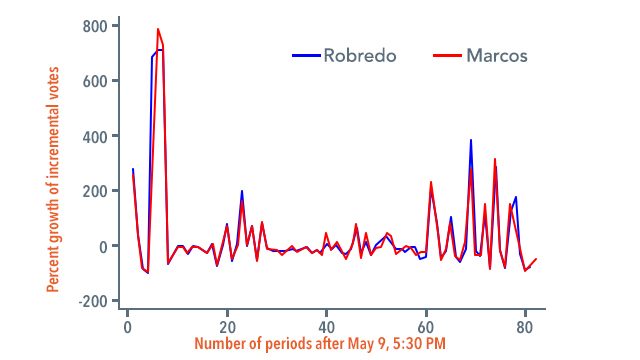
A very high correlation of the growth rates between Leni and Bongbong’s votes means that when Bongbong’s votes increased or decreased in one period, Leni’s votes mirrored those changes very closely. Whatever advantage Leni gained came from the accumulation of very small gaps between these otherwise highly correlated growth rates.
Taken together, these patterns would tend to debunk rather than support any allegation of cheating on Leni’s part.
2) Bongbong’s votes just arrived earlier than Leni’s votes.
A good explanation of why Leni’s votes seem to have overtaken Bongbong’s votes in the morning of May 10 is that some regions transmitted their results earlier than others.
First, note that both Bongbong and Leni had bailiwicks of their own (see Figure 2). On the one hand, Bongbong enjoyed a landslide win in northern regions like CAR, Regions I, II, III, and NCR. On the other hand, Leni enjoyed significant support in the southern regions, notably in Bicolandia, the Visayas, and Mindanao.
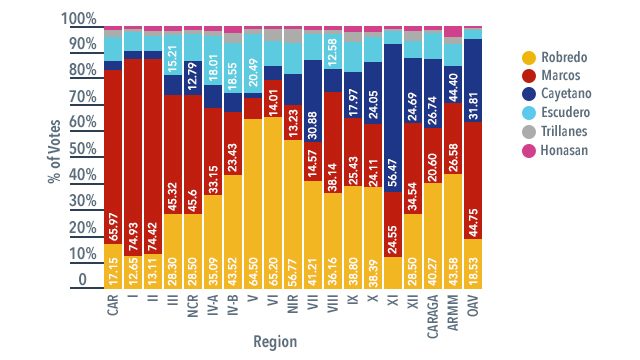 Figure 2. Source: Rappler. Note: Thinking Machines also made an interactive map using the same data.
Figure 2. Source: Rappler. Note: Thinking Machines also made an interactive map using the same data.
At the same time, the data clearly show that the votes from Luzon came in first, followed by Visayas and Mindanao. Dr. Reina Reyes summarized this fact beautifully in an animated graph (see Figure 3).
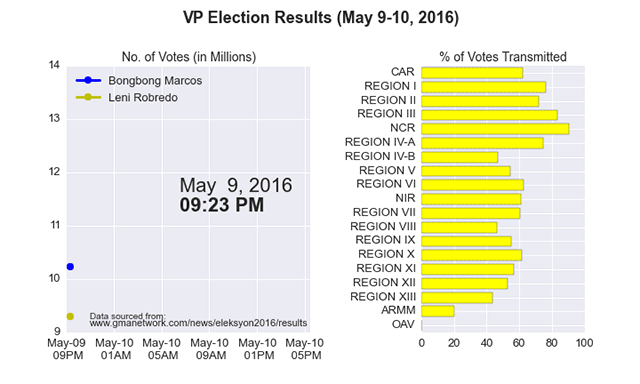
Since Bongbong won overwhelmingly in the regions which first transmitted results, it’s not surprising to see that Bongbong seemed to win in the initial hours after the elections, only to be overtaken by Leni later on.
Many other data analysts have corroborated this result. For instance, a group of other researchers made a similar analysis and animation (see Figure 4) and reached the same conclusion.
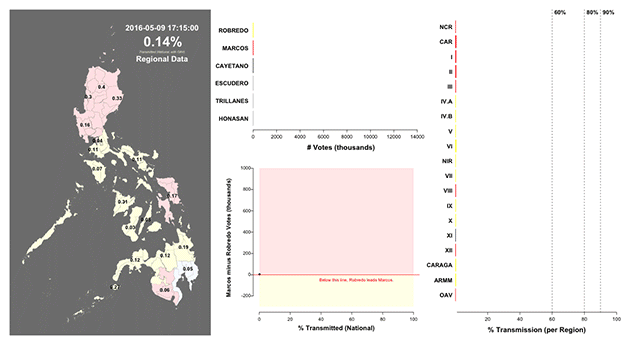
Meanwhile, Peter Cayton showed that while votes from Luzon and NCR came in a single big “wave,” votes from other parts of the country arrived in multiple waves due to difficulties in transmission.
Finally, Miguel Barretto Garcia showed that even before the midnight of May 9 it was statistically clear that Leni would win.
3) There was also no evidence of suspicious electoral “fingerprints.”
A more rigorous way of detecting electoral fraud is by observing several precincts where a particular candidate or party won unanimously (or near-unanimously).
This method of detecting “fingerprints” in the data is one of the more advanced ways of detecting electoral fraud in the academic literature. Rappler’s Gemma Mendoza had used this method before to show high probabilities of cheating in Maguindanao and Lanao del Sur in the 2010 elections.
For the 2016 elections, Dr. Christian Alis applied the same methodology using precinct-level data and found that no such electoral fingerprints could be detected among all vice presidential candidates, including Bongbong and Leni.
Figure 5 below shows the distribution of Leni’s votes across different precincts, with voter turnout on the horizontal and Leni’s share of votes on the vertical. If Leni won by ballot stuffing, reporting of contrived numbers, or other methods of electoral fraud, then one should observe a dark spot (resembling a fingerprint) on the extreme upper-right corner of the graph.
But no such spot can be observed from the actual data, and this again does not show any indication of cheating on Leni’s part.
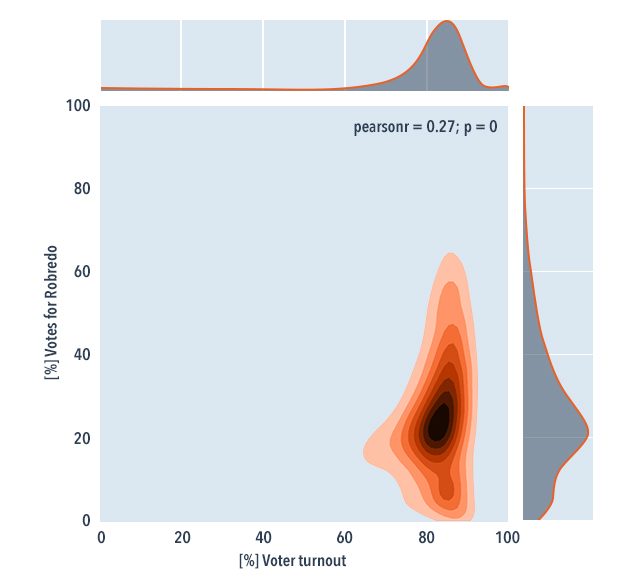 Figure 5. Source: Christian Alis. Note: TJ Palanca also made a related analysis.
Figure 5. Source: Christian Alis. Note: TJ Palanca also made a related analysis.
Conclusion: Leni did not “steal” the vice presidency
It’s often said that Filipino politicians either win the elections or get cheated (they never lose). Never has this been more pronounced than in the 2016 vice presidential race, which we sadly continue to dispute nearly 7 months after the elections.
It’s true that Leni won by a slim margin of just 263,473 votes. This number is just as large as the entire population of Lucena City or Catanduanes province as of 2015.
But by examining the election data and subjecting it to various methodologies, it is virtually impossible for anyone to conclude that Leni cheated and “stole” the vice presidency. The data tells us that she won fair and square.
Of course, the Supreme Court, acting as the Presidential Electoral Tribunal, will rely on a wider array of evidence—including testimonies or expert opinions—to prove or disprove Bongbong’s claims of electoral fraud.
But unlike witnesses, the data don’t lie. This is something we should all bear in mind as we continue to monitor the vice presidential contest in the coming weeks and months. All of us could be affected by the outcome of this protracted dispute, so we must all remain vigilant. – Rappler.com
The author is a PhD student and teaching fellow at the UP School of Economics. His views do not necessarily reflect the views of his affiliations. Thanks to friends and colleagues who have given permission to feature their graphics, and to Kevin Mandrilla for helpful comments and suggestions.
Add a comment
How does this make you feel?
There are no comments yet. Add your comment to start the conversation.